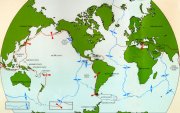| 1. |
Plates that are subducting move slower than plates that are not subducting.
 False False
 True True
|
|
| 2. |
Name and describe the three types of collisions that occur at convergent boundaries.


|
|
| 3. |
The only boundaries that do not produce magma are ______.
 Transform boundaries Transform boundaries
 Divergent boundaries Divergent boundaries
 Subduction boundaries Subduction boundaries
 Convergent boundaries Convergent boundaries
|
|
| 4. |
Explain slab pull.


|
|
| 5. |
Scientists use ______ to identify plate boundaries.
 Fracture zones Fracture zones
 Volcanoes Volcanoes
 Earthquakes Earthquakes
 All of the above All of the above
 B and C B and C
|
|
| 6. |
How are transform boundaries different from divergent boundaries?


|
|
| 7. |
Tectonic plates include the continental crust.
 False False
 True True
|
|
| 8. |
Explain mantle convection.


|
|


 1 Once Wegener and other scientists began studying the movement of our continents, more hypotheses and theories were developed. During the 1960's scientists developed the theory of plate tectonics. This theory explains the reason continents move and change our planet's crust.
1 Once Wegener and other scientists began studying the movement of our continents, more hypotheses and theories were developed. During the 1960's scientists developed the theory of plate tectonics. This theory explains the reason continents move and change our planet's crust.